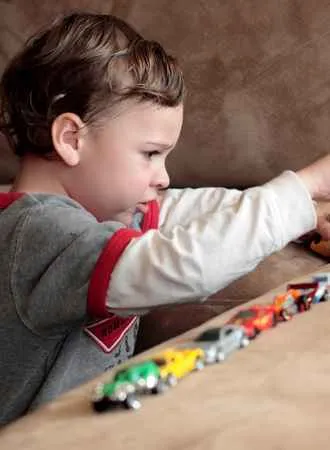Did you know that your toddler child’s interest and love of play could be the key to unlocking their full potential?
Welcome to the magic of schema play!
This exciting and interactive form of play-based learning is vital for your child’s development, helping them to explore, experiment, and develop vital cognitive, social, and emotional skills.
In this article, we’ll take a closer look at schema play, explore the different types of play, how many schemas there are, and provide practical tips and insights on how to encourage schema play in your toddler.
Schema play is a vital part of a toddler’s development, helping them to explore, experiment, and develop vital cognitive, social, and emotional skills.
There are nine common types of schema play in toddlers, each with its own set of behaviors and characteristics.
Encouraging schema play in toddlers is easy with the right materials, activities, and environment. By observing your child’s play, providing open-ended toys, and joining in the play, you can unlock the magic of schema play and support your child’s learning and development.
Understanding Schema Play
As a parent or caregiver of many children, you may have noticed that toddlers love to play. But did you know that their play can actually be a key factor in their cognitive development?
Schema play, also known as schematic play, is a type of play-based learning that is vital for a toddler’s cognitive, social, and emotional development.

What is Schema Play?
Schema play is a type of play that involves repeated patterns of behavior or “schemas” that children engage in as they explore and make sense of the world around them. Schemas are like a set of instructions that children follow as they play.
They are not fixed or rigid patterns, but rather flexible and adaptable ways of thinking and acting that allow children to explore and learn about the world in their own unique way.
Through schema play, toddlers learn to make sense of the world around them and develop their cognitive, social, and emotional skills. They use schema play to explore and experiment with different materials and objects, which helps them develop their problem-solving skills.
For example, a toddler who enjoys transporting objects from one place to another is exhibiting a schema called “transporting.” This transportation schema helps them understand the concept of distance and space.

The Importance of Schema Play in Toddler’s Development
Schema play is crucial for a toddler’s development as it allows them to make sense of the world around them and develop their cognitive, social, and emotional skills. By engaging in schema play, toddlers learn to problem-solve, be creative, and develop their fine motor skills.
In addition, schema play allows toddlers to explore and experiment with different materials and objects, which helps them develop their problem-solving skills.
For example, a toddler who enjoys creating boundaries by wrapping objects or throwing toys up in blankets is exhibiting a schema called “enveloping.” This schema helps them understand the concept of containment and control.
Specific Examples of Schema Play For Toddlers
There are many different types of schemas, each with its own set of behaviors and characteristics. Some common schemas in toddlers include:
- Transporting: Moving objects from one place to another
- Rotation: Spinning or turning objects around
- Enveloping: Wrapping objects up or hiding them
- Positioning: Placing objects in a particular position or arrangement
- Trajectory: Exploring how objects move through space, such as throwing balls or jumping off of things
- Orientation: Exploring how objects are positioned in space, such as lining up toys or arranging objects in a certain way
- Transforming: Exploring how objects change, such as pouring water from one container to another or playing with play-dough
- Enclosure: Creating enclosed spaces, such as building forts or hiding under blankets
- Positioning: Arranging objects in specific ways, such as lining up cars or sorting toys by color

It’s important to note that children may engage in one or more very different play schemas at any given time, and may switch between them as they explore and learn.
Schema play is an important part of early childhood development, as it allows children to develop their cognitive, social, and emotional skills in a fun and engaging way.
Common Misconceptions About Schema Play
Despite its importance, there are still some misconceptions about schema play. One common misconception is that schema play is just “messing around” or playing aimlessly. However, in schema theory, play is actually a purposeful and intentional form of play-based learning.
Another misconception is that schema play is only important for toddlers. In reality, schema play is important for children of all ages, including preschoolers and elementary-aged children. By continuing to support and encourage schema play, children can continue to learn and grow through play.

Benefits of Schema Play
Schema play is not just a fun way for toddlers to pass the time. It has several benefits that can help with their cognitive, physical, and emotional development. Here are some of the benefits of schema play:
Develops problem-solving skills:
When toddlers engage in schema play, they are constantly figuring out how to make things work. This helps them develop problem-solving skills that they will use throughout their lives. For example, if a toddler is playing with blocks, they may try different angles and ways of stacking them to see which way works best.
Similarly, an older child who is experimenting with transforming schema by pouring water from one container to another is developing their problem-solving skills and critical thinking abilities.
Encourages creativity:
Schema play allows children to use their imagination and come up with new ways of doing things. This encourages creativity and helps them think outside the box. For example, a child who is engaging in transporting schema might use a wagon, stroller, or other mode of transportation to move objects around and the children explore these new ways of moving things.

Improves fine and gross motor skills:
Many schema play activities require children to use their hands and fingers in precise ways. This helps improve their fine motor skills, which will be important when they start learning to write. For example, a child who is exploring enveloping schema might practice wrapping objects up in different ways, improving their dexterity and fine motor control.
Builds confidence:
As children learn to figure out how to do things on their own through schema play, they gain confidence in their abilities. This can help them feel more independent and capable. For example, a child who is exploring trajectory schema by throwing a ball and catching it will gain confidence in their ability to catch and throw.
Schema play can be done alone or with others. When children play with others, they learn important social skills like sharing, taking turns, joining things, and cooperating. For example, a group of children who are engaging in enclosure schema might work together to build a fort or hide under a large blanket, developing their social skills and ability to work together.
Overall, schema play is an important part of a child’s development. By recognizing and supporting child development through schema play, parents and caregivers can help facilitate a child’s learning and growth. With the right support and encouragement, children can continue to learn and develop through play, building important cognitive, social, and emotional skills that will serve them well throughout their lives.

Schema play is a type of play-based learning that involves repeated patterns of behavior or “schemas” that children engage in as they explore and make sense of the world around them.
Common schemas in toddlers include transporting, rotation, enveloping, positioning, trajectory, orientation, transforming, enclosure, and positioning.
Schema play is important for a child’s cognitive, social, and emotional development and helps develop problem-solving skills, encourages creativity, improves fine motor skills, builds confidence, and encourages social interaction.
Common misconceptions about schema play include that it is aimless or only important for toddlers, when in reality it is a purposeful and intentional form of play-based learning that is important for children of all ages.
Types of Schema Play For Toddlers
Schema play is a crucial part of a toddler’s development. In this section, we will explore the nine common types of schema play and provide specific examples of each.
Transporting Schema
Transporting schema involves moving objects from one place to another. For example, a child might enjoy carrying toys around in a bag or pushing a stroller. This type of schema play helps toddlers understand the concept of distance and space.
Rotation Schema
Rotation schema involves spinning or turning objects around. For example, a child might enjoy playing with a top or spinning in circles. This type of schema play helps toddlers understand concepts like speed and direction.
Enveloping Schema
Enveloping schema involves wrapping objects up or hiding them. For example, a child might enjoy pretending to be a mummy or wrapping toys in blankets. This type of schema play helps toddlers understand concepts like containment and boundaries.
Orientation Schema
Orientation schema involves exploring how objects are positioned in space. For example, a child might enjoy lining up toys or arranging objects in a certain way. This type of schema play helps toddlers understand concepts like symmetry and balance.
Positioning Schema
Positioning schema involves arranging objects in specific ways. For example, a child might enjoy sorting toys by color or lining up cars. This type of schema play helps toddlers understand concepts like categorization and organization.
Trajectory Schema
Trajectory schema involves exploring how objects move through space. For example, a child might enjoy throwing balls or jumping off of things. This type of schema play helps toddlers understand concepts like gravity and cause and effect.
Transforming Schema
Transforming schema involves exploring how things change. For example, a child might enjoy pouring water from one container to another or playing with play-dough. This type of schema play helps toddlers understand concepts like cause and effect and transformation.
Enclosure Schema
Enclosure schema involves creating enclosed spaces. For example, a child might enjoy building forts or hiding under blankets. This type of schema play helps toddlers understand concepts like shelter and protection.
Connection Schema
Connection schema involves exploring how things fit together. For example, a child might enjoy fitting puzzle pieces together or building with blocks. This type of schema play helps toddlers understand concepts like structure and design.
It’s important to note that toddlers may engage in multiple types of schema play at once. Additionally, these play schemas can evolve over time as young children grow and develop, with particular schemas becoming more complex.
Understanding a child’s schemas can help parents and caregivers of connection children provide appropriate materials and activities that support their learning and development. By observing and recognizing a child’s different schemas themselves, parents and caregivers can provide opportunities for further exploration and learning, supporting their child’s cognitive, social, and emotional development.
Play schemas involves nine common types of play, including transporting, rotation, enveloping, orientation, positioning, trajectory, transforming, enclosure, and connection. Toddlers may engage in multiple types of schema play at once, and these understanding play schemas can evolve over time, becoming more complex as children grow and develop.
Encouraging Play Schemas
Schema play is a vital part of a toddler’s development, allowing them to make sense of the world around them and develop important cognitive, social, and emotional skills.
Identifying Schemas in a Child’s Play
Observing a child’s play is the first step in identifying their schemas. Here are some common signs of schema play:
- Repeating certain behaviors: Children will often repeat certain behaviors or actions as they explore and make sense of the world around them.
- Engaging in similar play activities: Children will often engage in similar play activities that revolve around a particular theme or interest.
- Showing a preference for certain toys or objects: Children may have a strong preference for certain toys or objects that relate to their schema play.
By observing a child’s play, parents and caregivers can identify their play schemas important, and provide appropriate materials and activities that support their learning and development.
Practical Tips for Encouraging Schema Play
Here are some practical tips for encouraging schema play in toddlers:
- Provide open-ended toys: Open-ended toys, such as blocks, play dough, and dress-up clothes, allow children to use their imagination and creativity to engage in schema play.
- Create a safe and stimulating environment: A safe and stimulating environment will encourage children to explore and engage in schema play. Make sure that the environment is free from hazards and that there are plenty of toys and materials for your child to play with.
- Follow your child’s lead: Let your child take the lead in their play and follow their interests and schemas. This will help them feel empowered and in control of their play, which can lead to more engagement in schema play.
- Join in the play: Joining in your child’s play can be a great way to encourage schema play. It can also be a fun way to bond with your child and learn more about their interests and schemas.
Specific Examples of Activities for Each Type of Schema Play
Here are some specific examples of activities for children exploring each type of schema play:
- Transporting schema: Provide toy cars, trucks, and trains for your child to move around a track or across the floor.
- Rotation schema: Provide tops, spinning toys, and balls for your child to roll and spin.
- Enveloping or Enclosing schema: Provide blankets, scarves, and boxes for your child to wrap objects up and hide them.
- Orientation schema: Provide building blocks, puzzles, and sorting toys for your child to explore how objects are positioned in space.
- Positioning schema: Provide stacking toys, sorting toys, and shape sorters for your child to arrange objects in specific ways.
- Trajectory schema: Provide balls, frisbees, and jumping toys for your child to explore how objects move through space.
- Transforming schema: Provide play dough and playdough tools, water, and sand for your child to explore how things change.
- Enclosure schema: Provide cardboard boxes, blankets, and tents for your child to create enclosed spaces.
- Connection schema: Provide building blocks, legos, and other construction toys for your child to explore how things fit together.
The Importance of a Safe and Stimulating Environment
Creating a safe and stimulating environment for schema play is crucial for a child’s development. Here are some key factors to keep in mind:
- Remove hazards: Make sure that the environment is free from hazards, such as sharp objects, small parts, and unstable furniture.
- Provide a variety of materials and toys: Make sure that there are plenty of toys and materials for your child to play with. This will encourage exploration and creativity.
- Rotate toys regularly: Rotating toys regularly will help keep your child engaged and interested in their play. It also helps them discover new interests and schemas.
- Allow for independent exploration: While joining in on play is important, it’s also essential to allow for independent exploration. This allows children to explore their schemas and interests at their own pace, which can foster independence and self-confidence.
Identifying schemas in a child’s play is the first step in encouraging schema play.
Providing open-ended toys, creating a safe and stimulating environment, and following your child’s lead are practical tips for encouraging schema play.
Specific examples of activities for each type of schema play can help parents and caregivers support their child’s learning and development.
Creating a safe and stimulating environment for schema play is crucial for a child’s development and learning.
Allowing for independent exploration fosters independence and self-confidence.
FAQs on Understanding and Encouraging Schema Play in Toddlers
What is schema play?
Schema play refers to the patterns of behavior and repeated actions that young children engage in as they explore their environment and learn new concepts. Schemas are essential building blocks in cognitive development, helping children to understand, categorize, and make connections between different experiences.
Why is schema play important for toddlers?
Schema play is crucial for a toddler’s development as it contributes to various aspects of their growth, including cognitive, social, emotional, and motor skills. By engaging in schema play, toddlers can develop problem-solving abilities, creativity, understanding of cause and effect relationships, fine and gross motor skills, and self-confidence.
What are the different types of schema play?
Common types of schema play in toddlers include trajectory schema (movement-related actions), rotation schema (spinning, rolling, and twisting), enclosure schema (creating boundaries with objects), connecting schema (linking objects together), and transporting schema (moving objects from one place to another).
How can parents support schema play at home?
Parents can support schema play at home by providing age-appropriate toys and materials for different schema play activities, observing their child’s interests, and incorporating schema play into daily routines and activities.
How does schema play evolve as a child grows?
As children grow, their schema play evolves, and they engage in more complex activities. For example, a younger toddler may engage in simple stacking and filling activities, while an older toddler might create enclosures with pillows or engage in more advanced pretend play.
What are the benefits of schema play for a toddler’s development?
Schema play offers numerous benefits for a toddler’s development, including enhancing cognitive skills (problem-solving and critical thinking), social skills (sharing, cooperation, and communication), emotional development (self-confidence and independence), and motor skills (fine and gross motor abilities).
Are there any challenges for parents in supporting schema play?
Some common challenges parents might face when supporting schema play include understanding their child’s interests, managing messes and potential risks, and balancing schema play with other activities. To overcome these challenges, parents can observe and engage with their child during playtime, set boundaries for messy play, and encourage a variety of play experiences.
How does schema play relate to the Montessori method?
The Montessori method of education aligns with the concept of schema play, emphasizing the importance of child-led, hands-on learning experiences. Parents can incorporate Montessori-inspired activities into their child’s schema play to support their development further, such as providing open-ended materials and toys, encouraging independent exploration, and offering activities that promote practical life skills.
What is the Froebel Early Education Project
The Froebel Early Education Project is an educational approach inspired by the work of Friedrich Froebel, a German pedagogue who is considered the founder of the kindergarten system. Froebel’s philosophy emphasizes the importance of play in a child’s learning and development, as well as the role of the environment, materials, and adult guidance in fostering this growth. It aims to apply these principles to create meaningful and engaging learning experiences for young children, transforming children.
At what age does schema play happen?
Schema play can begin as early as infancy and continue throughout early childhood. However, it is most commonly observed and prominent in toddlers, typically between the ages of 12 months and 3 years. As children grow and develop, their schema play evolves, and they engage in more complex and varied activities related to different schemas.




